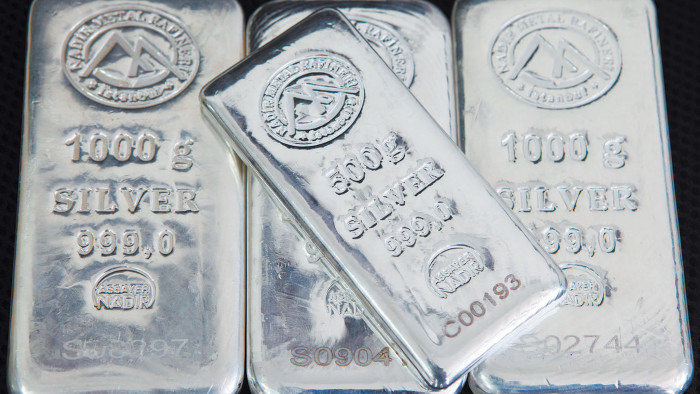Calls for consumers to back ethical silver

Roula Khalaf, Editor of the FT, selects her favourite stories in this weekly newsletter.
The revolution in ethical gold and diamonds is about to encompass silver.
Ethically sourced and environmentally sensitive precious stones and metals have seen a steady rise in global demand since the turn of the millennium.
A Fairtrade scheme for gold gained traction in 2011, and last year a Fairtrade silver scheme was launched in the UK.
Many jewellers have switched to silver from traceable sources and away from the largely unregulated, artisanal mining industry or suppliers using environmentally unsound methods of extraction.
But ethical silver is still in gold’s shadow, despite efforts by the Fairtrade Foundation and the Alliance for Responsible Mining to boost traceable metals, says Greg Valerio, founder of Cred, an ethical jeweller.
The sticking-point is cost.
Most artisanal miners are not environmentally conscious, largely because silver is relatively cheap. They make what little money they can from gold and, because silver is a byproduct of gold mining, it is difficult to persuade them to adopt cleaner, more costly processes.
The supply chain, too, is tarnished, Mr Valerio says. The price of silver, currently $19.4 a troy ounce, is still far below gold, whose lustre diminished over 2013 but is still priced at $1,226.2 an ounce. Why pay more to source and import ethical silver when margins are already tight?
There is also a lack of awareness among consumers about the importance of buying sustainable silver.
Alan Frampton, who bought Cred from Mr Valerio in 2009, says he is surprised that buyers are discerning about the provenance of their food but not their jewellery. He is hoping to lead by example: “We want to know where our silver has come from, especially as mining is still a dirty business.”
Slowly, Fairtrade is helping producers improve the way they extract and purify silver. Mr Valerio says: “In 2004, I visited Oro Verde, a pioneering small-scale mining initiative in Colombia that does not use cyanide and has a traceable supply chain. This catalysed the launch of Fairtrade Gold.”
From this scheme, which relies on panning and diving for sediment, have emerged four Latin American Fairtrade gold mines and nine African pilot projects producing both gold and silver. The hope is that Fairtrade mines will make it easier to source ethical silver while improving the lives of miners.
Ute Decker, the architectural jeweller, has used Fairtrade gold since 2011, but until recently could not find ethical silver – the closest alternative, she says, was a recycled material, although the traceability of the original pieces was questionable.
She is switching to Fairtrade. “It is much better to create an artisanal piece that has helped support other artisans,” she says.
Jon Dibben, a fine jewellery designer whose special-edition collars can cost about £50,000, says demand for silver jewellery could grow this year, as fashion-conscious customers turn to it “psychologically” for its price and versatility.
He says: “It only costs maybe £40 more to design bespoke pieces out of Fairtrade metal than non-specific metal. So why not go Fairtrade?”
High-end retailers are also taking their corporate social responsibility over silver seriously.
Anisa Kamadoli Costa, vice-president for global sustainability and corporate responsibility at Tiffany & Co, says: “We believe our customers trust us to ensure the jewellery we craft was extracted and created in an ethical and responsible way.”
Tiffany has traceability and control throughout the supply chain, she says. In 2012, 83 per cent of the silver used in its own manufacturing facilities came from one large-scale mine in the US, with 17 per cent from recycled sources.
Other jewellers are starting to use ethically sourced precious metals. Garrard, the world’s oldest jeweller, signed up to sell Fairtrade gold.
Danish jeweller Georg Jensen openly states its commitment not to support human rights abuses in the supply chain. But Mr Frampton says more should be done to get consumers on board.
He and the 27 other jewellers that have signed up to the Fairtrade gold scheme have made 2014 the year to challenge consumers to inquire about the origin of the metals they are purchasing, so that more pressure can be put on suppliers.
The Fairtrade Foundation is campaigning among faith groups in the UK, using Fairtrade wedding bands as bait to promote ethical jewellery.
Mr Valerio is optimistic: “This is a vanguard movement and the British public will get it.”
——————————————-
Silver extraction: a risky process
In the 1500s, Spanish mines in the Americas used mercury to extract a purer form of silver from gold and other metals.
The silver in the ore would form an amalgam with mercury and be extracted more efficiently after blasting with tonnes of water.
Today, cyanide has replaced mercury in most mines around the world, but mercury is still used by many artisanal miners. Both substances are dangerous to human health and high levels of mercury and cyanide are often found in water and farmland near gold mining communities, according to the Fairtrade Foundation.
Up to 90 per cent of workers around the world involved in mining are artisans, the foundation estimates. Those workers produce about 15 per cent of the world’s gold.
Comments